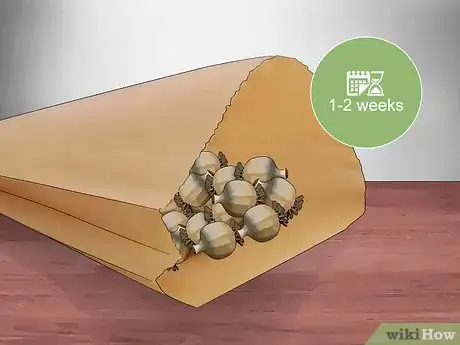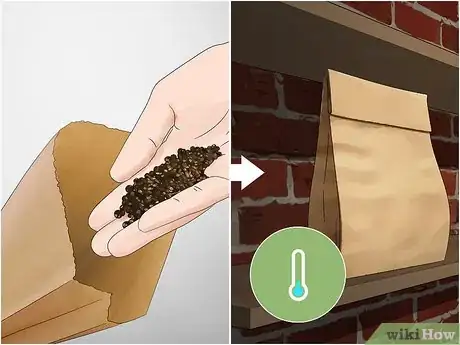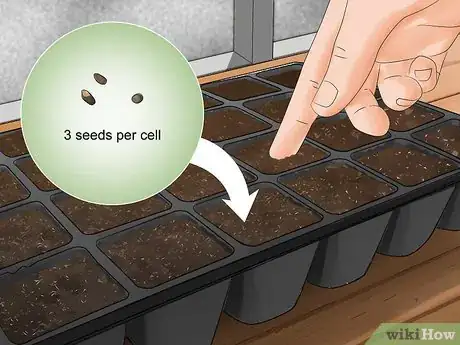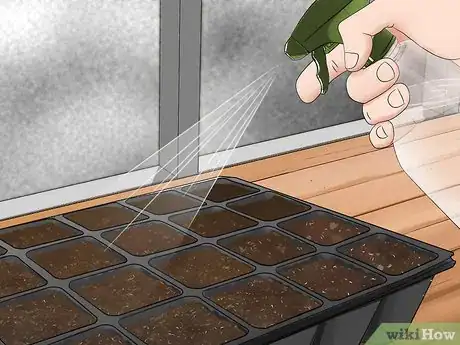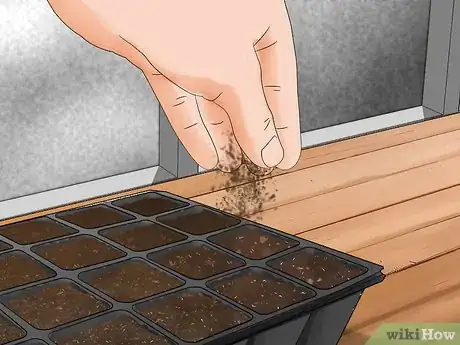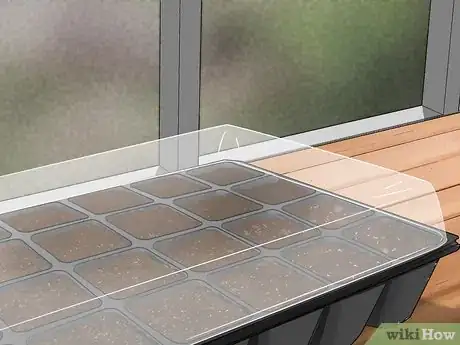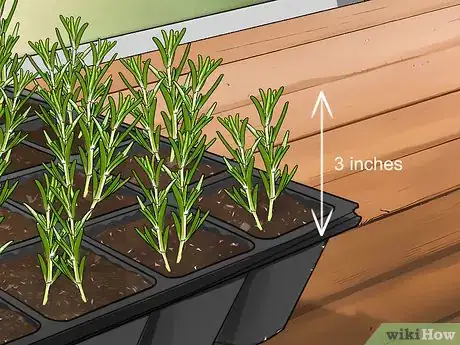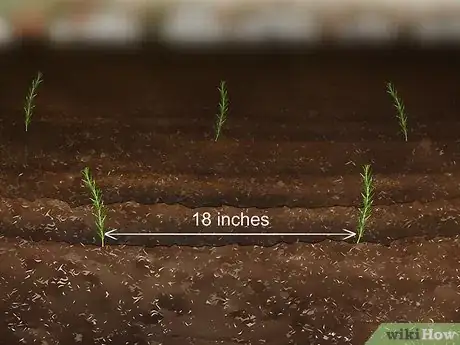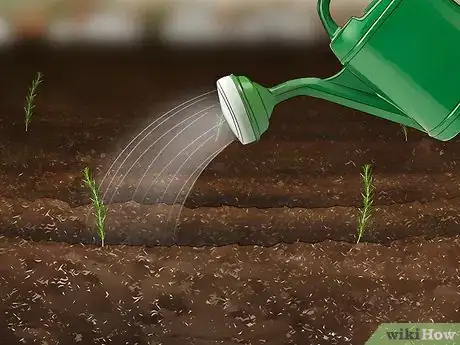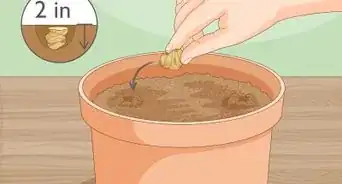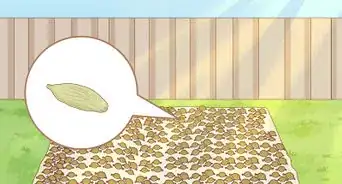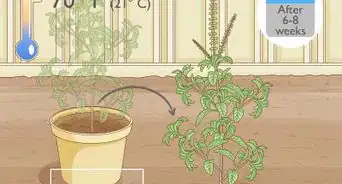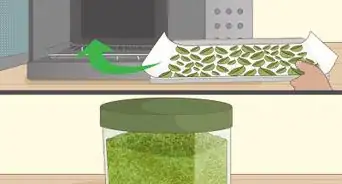This article was co-authored by Lauren Kurtz. Lauren Kurtz is a Naturalist and Horticultural Specialist. Lauren has worked for Aurora, Colorado managing the Water-Wise Garden at Aurora Municipal Center for the Water Conservation Department. She earned a BA in Environmental and Sustainability Studies from Western Michigan University in 2014.
There are 12 references cited in this article, which can be found at the bottom of the page.
wikiHow marks an article as reader-approved once it receives enough positive feedback. In this case, 80% of readers who voted found the article helpful, earning it our reader-approved status.
This article has been viewed 181,249 times.
Rosemary is an edible perennial evergreen shrub that’s often used in cooking. You can buy fresh or dried rosemary at the grocery store, but you can also grow your own in the garden. Planting rosemary from seed takes time, and it’s important to get a head start on germination many weeks before you'd want to move the herb outside. The trick with growing rosemary from seed is patience, because this plant is a slow grower when propagated from seed.
Steps
Harvesting Rosemary Seeds
-
1Watch for the seed pods to form and dry out. A rosemary plant will produce flowers in spring or summer. When the flowers die back, seed pods will grow in their place. After the seed pods form, wait for them to develop and eventually dry out and turn brown. That’s when they're ready to be harvested.[1]
- You can also buy rosemary seeds from nurseries and garden stores if you don’t have a plant to harvest them from.
-
2Collect the seed pods. The seed pods are very small, and you can remove them from the plant by pinching them off with your fingers. As you collect the pods, place them in a cup or small bowl to keep them all together.[2]Advertisement
-
3Dry the pods. Bring the pods inside and transfer them to a paper bag. Leave the bag open to allow air flow. Place the bag in a warm, dry place away from direct sunlight for 1 to 2 weeks. This will give the pods and seeds time to finish drying out.[3]
- The pods are dry when they're completely brown and all the moisture is gone.
-
4Rub the pods to remove the seeds. Place the seed pods onto a clean tea towel. Fold the towel over the pods and rub the towel between your hands to separate the seeds from the pods, and to remove any husks or flower matter. Open the towel and pick out the seeds, which are small, brown, and egg-shaped. Discard the pods and other plant matter.
-
5Store the seeds somewhere cool and dry. Transfer the seeds to a paper bag and seal the bag to keep the seeds inside. You can store the seeds for up to a year, as long as they stay cool and dry. A root cellar or basement is an ideal location for seed storage.[4]
Germinating the Seeds
-
1Aim to start the seeds in mid winter. Rosemary seeds take a long time to germinate and the seedlings are slow to grow. The seedlings can be transplanted outside in mid spring, but they need to be started inside 10 to 12 weeks before the last frost.[5]
- Check local government or weather sites to find out the last expected frost date where you live.
-
2Fill seed starters with soilless potting mix. Rosemary naturally grows in sandy and rocky soil, so the seeds will do better in a loose and light potting mix that doesn’t contain soil. Good potting media for rosemary include:
- Sand-based mixes
- Vermiculite
- Pearlite, bark, and peat[6]
-
3Sprinkle 3 to 4 seeds into each cell. Rosemary doesn’t have a very high germination rate, so you can increase your chances of success by planting multiple seeds in each cell. Lay the seeds on top of the potting medium without pressing them down into the soil.[7]
-
4Mist the seeds with water. Once you’ve place the seeds on the medium, use a spray bottle to mist the seeds with a few spritzes of water. This will help to settle the seeds in the medium and prevent them from being knocked around.[8]
-
5Cover the seeds with a light layer of soil. Dust a very small amount of regular potting soil over the entire surface of the growing medium to just cover the seeds. Then, mist the soil with a few more spritzes of water to dampen it. You want the soil moist but not wet.[9]
-
6Cover the trays with plastic. You can either use plastic growing domes, or cover the tray with a layer of plastic wrap. This will keep in moisture and warmth, and help the seeds to germinate faster. Leave the plastic on the tray until the seedlings sprout and push up through the soil.[10]
- Germination will take anywhere from 15 to 25 days.[11]
-
7Transfer the seeds to a sunny and warm location. Rosemary seeds need both warmth and light to germinate, so it’s important to find a sunny location for the seeds. Place the seed trays in a bright location that gets direct sunlight every day.
- The ideal temperature for germinating rosemary is between 70 and 80 °F (21 and 27 °C).[12]
- You can also place the trays on a heating mat to keep the rosemary seeds warm if you live in a cool climate or if the seeds aren't getting enough light.
-
8Keep the soil moist but not wet. Use the spray bottle to moisten the soil when the top starts to dry out. Rosemary is prone to a condition called damping off, which is a disease caused by fungi and mold. You can help prevent it by watering minimally.[13]
Transplanting and Growing Rosemary
-
1Wait for the seedlings to reach 3 inches (7.6 cm)in height. Rosemary seedlings will do best if you don’t transplant them until they're well-established, the risk of frost has past, and the ground has had time to warm up. If you started the seeds inside 10 to 12 weeks before the last frost, the rosemary should be ready to go outside in late May to early June.[14]
- You can either transplant the rosemary directly to the garden, or grow it in a pot so you can bring it inside in winter.
-
2Choose a location with full sun. Rosemary needs lots of direct sunlight to thrive. The plant will do best somewhere that gets at least 6 to 8 hours of sun every day.[15] This is especially true if you want to grow the rosemary indoors over the winter.
-
3Amend the soil for drainage. Before planting the rosemary, till the soil to a depth of about 12 inches (30 cm). To improve the drainage of the soil, add 3 to 4 inches (7.6 to 10.2 cm) of sand, aged compost, or rotted manure to the garden bed and till it into the soil.
- This is especially important if your soil has a high clay content, because rosemary needs well-draining soil.
-
4Plant the rosemary in rows. Use a spade or your hand to dig holes in the soil that are large enough to accommodate the rosemary root balls. Space the holes 18 to 24 inches (46 to 61 cm) apart.[16] Place one rosemary plant in each hole and cover the roots with fresh soil.
-
5Water when the soil dries out. Rosemary is somewhat drought-resistant and doesn’t like to be overwatered. But it’s also important that the roots don’t dry out. When the top of the soil dries out, water the plant thoroughly to soak the soil and the roots.[17]
Expert Q&A
Did you know you can get expert answers for this article?
Unlock expert answers by supporting wikiHow
-
QuestionHow large or big does my plant need to be before I harvest it? How long will it take?
 Lauren KurtzLauren Kurtz is a Naturalist and Horticultural Specialist. Lauren has worked for Aurora, Colorado managing the Water-Wise Garden at Aurora Municipal Center for the Water Conservation Department. She earned a BA in Environmental and Sustainability Studies from Western Michigan University in 2014.
Lauren KurtzLauren Kurtz is a Naturalist and Horticultural Specialist. Lauren has worked for Aurora, Colorado managing the Water-Wise Garden at Aurora Municipal Center for the Water Conservation Department. She earned a BA in Environmental and Sustainability Studies from Western Michigan University in 2014.
Professional Gardener
-
QuestionHow do I collect rosemary seeds?
 Community AnswerOnce the flowers dry up, they will be replaced by seed pods. You can either use these by pulling them off, or use store-bought seeds.
Community AnswerOnce the flowers dry up, they will be replaced by seed pods. You can either use these by pulling them off, or use store-bought seeds. -
QuestionWhich pollinators pollinate rosemary?
 Community AnswerHoneybees love rosemary.
Community AnswerHoneybees love rosemary.
References
- ↑ http://www.everwilde.com/store/Rosemary-Herb-Seeds.html
- ↑ https://youtu.be/TzA9CHbTZ1w?t=25
- ↑ https://www.globalseednetwork.org/seed-tips-detail.php?id=44
- ↑ http://www.everwilde.com/store/Rosemary-Herb-Seeds.html
- ↑ https://youtu.be/8ouLMsGuLBM?t=4
- ↑ https://youtu.be/b65Fx5Ekn8s?t=161
- ↑ https://youtu.be/8ouLMsGuLBM?t=30
- ↑ https://youtu.be/b65Fx5Ekn8s?t=184
- ↑ http://www.burpee.com/gardenadvicecenter/herbs/rosemary/how-to-grow-rosemary-from-seed/article10491.html
- ↑ http://www.burpee.com/gardenadvicecenter/herbs/rosemary/how-to-grow-rosemary-from-seed/article10491.html
- ↑ http://herbgardening.com/growingrosemary.htm
- ↑ https://www.westcoastseeds.com/how-to-grow-guides/grow-rosemary/
- ↑ https://www.westcoastseeds.com/how-to-grow-guides/grow-rosemary/
- ↑ https://www.westcoastseeds.com/how-to-grow-guides/grow-rosemary/
- ↑ https://www.thekitchn.com/everything-you-need-to-know-about-growing-rosemary-221276
- ↑ http://veggieharvest.com/herbs/rosemary.html
- ↑ http://herbgardening.com/growingrosemary.htm
About This Article
To grow rosemary from seed, start the seeds indoors in mid-winter, 10-12 weeks before the last frost. Fill a seed starting tray with soilless potting mix, such as vermiculite or pearlite. Sprinkle 3-4 dried rosemary seeds on the surface of each compartment in the tray, then lightly mist the seeds with just enough water to help them stick to the surface of the growth medium. Dust the seeds with a thin layer of regular potting soil and mist the trays again, enough so that the soil is damp but not soggy. Cover the tray with a plastic growing dome or a sheet of plastic wrap to trap moisture and heat. Place the tray in a warm, sunny location, such as in a window that gets direct sunlight. Try to maintain a temperature of around 70-80° F (21-27° C) in the spot where you keep the trays. Any time the soil on top starts to dry out, mist it lightly with water. The seeds should start to germinate in 15-25 days. Once the seedlings are about 3 inches (7.6 cm) tall, transplant them into pots or directly into the ground in a spot where they will get full sun 6-8 hours a day. Choose a spot with well-drained soil and plant the seedlings in rows about 18 inches (46 cm) apart. Water your plants every time the soil at the surface starts to dry out.


